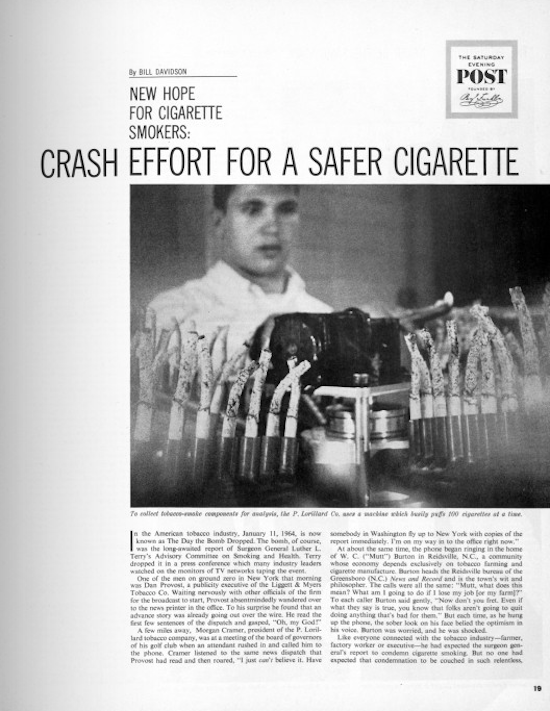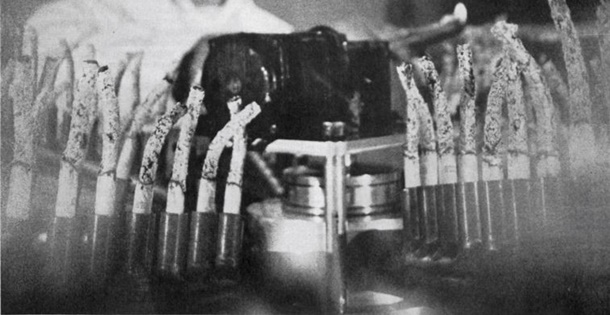Generations of Americans grew up hearing that smoking was an immoral, dirty habit that was doubtless bad for your health. But prior to 1964, there was no official link between cigarettes and serious illness. Then, on January 11, Surgeon General Luther Terry issued a 387-page report based on 7,000 pieces of research. He concluded that “cigarette smoking is a health hazard of sufficient importance in the United States to warrant appropriate remedial action.”
His unequivocal statement was the push millions of Americans needed to quit smoking. The tobacco industry, which had enjoyed continually rising sales since 1900, now saw its revenues drop alarmingly.
The industry, as well as its addicted smokers, clung to the idea that the report was somehow flawed. “The report is filled with discrepancies and unanswered questions,” complained one industry executive. Cigarette makers hired their own scientists to pick apart the Surgeon General’s findings. They argued there was no definitive proof of smoking’s connection to heart disease or cancer. Air pollution was just as likely a cause of lung cancer as cigarettes, they retorted.
But industry executives couldn’t argue away the drop in sales, which had fallen by 30 percent in some regions. The companies began multi-million-dollar marketing efforts. The number of smokers stopped its decline and started showing an increase.
The industry also spent millions to make cigarettes less dangerous. As Bill Davidson reported in “Crash Effort for a Safer Cigarette,” there was still a desperate hope that American ingenuity would develop a cigarette that could be smoked without guilt or fear.
Much of the industry’s hope was pinned on filtered cigarettes. The Surgeon General’s report had focused on cigarettes without filter tips, and Terry himself agreed it would be wrong to conclude that filters had no beneficial effect. It wasn’t an endorsement, but it was an encouragement.
One study found that charcoal filters eliminated toxins that interfered with some of the body’s defenses against cancer. When a new charcoal-tipped cigarette, named Lark, was launched, its sales skyrocketed.
Another approach was to mix the tobacco with presumably less toxic organic material like lettuce, spinach, and petunia leaves. But these adulterations often proved more carcinogenic than the tobacco. The Surgeon General’s report was the first of several setbacks that caused the tobacco industry to decline from its peak in 1964.
In 1965, the Federal Trade Commission required all cigarette packs to include the warning that “cigarette smoking is dangerous to health. It may cause death from cancer and other diseases.” In 1976, the Federal Communications Commission banned cigarette advertising from the airwaves.
In 1998, the four biggest tobacco companies settled a lawsuit brought by 46 states, which had spent billions caring for residents with tobacco-related illnesses. The states wanted some reimbursement from the companies. The settlement required the tobacco companies to change their marketing practices and to pay medical costs. In just the first 25 years, the companies are expected to pay $206 billion.
In the 2000s, electronic cigarettes began crossing the ocean from China to the U.S. They delivered the nicotine of cigarettes without the carcinogens of tobacco smoke. Within six years, the e-cigarette industry exceeded $1 billion in sales.
Definitive clinical studies on e-cigarettes’ health effects have not yet been submitted to the Food and Drug Administration. Doctors are already warning of e-cigarettes’ drawbacks: addiction to nicotine, damage to the heart and circulatory system, and developmental problems in fetuses, not to mention the toxic effect of flavoring additives.
Maybe somewhere down the road, another bomb will be dropped.

Featured image: Photo by Jim Mahan (SEPS)
Become a Saturday Evening Post member and enjoy unlimited access. Subscribe now




Comments
Oh I’m sure another bomb will be dropped down the road, and another one after that! How and why, at this late date there are still as many people smoking as there are is shocking to me, but I suppose it shouldn’t. We’re on a permanent high alert after all, be it events happening here, Europe or elsewhere.
There does seems to be a connection between nicotine and caffeine for many people, both of which are very addicting and unhealthy. The fact there’s a Starbucks and others on every other block is telling that America is a nation of addicts always looking for the next ‘fix’.
For many people coffee has replaced smoking, but that’s upped the sleep deprivation problem which just leads to more caffeine consumption. It’s become a vicious cycle. My ex-wife (who’s also a nurse) told me how many people are coming into the hospital fearful of rapid heartbeat from too much caffeine, and has said flat out energy drinks like Monster and Throttle are heart attacks in a can, and should have scary, severe warning labels on them.
They won’t until they’re forced to, like the cigarette industry. Meanwhile the existing laws forcing people to smoke outside need to updated, so it’s not just outside the door of whatever store or building. Fortunately, we have come a long way baby since this 1964 feature in a lot of ways. In others the article is still eerily current, and I suspect still will be in 2070.